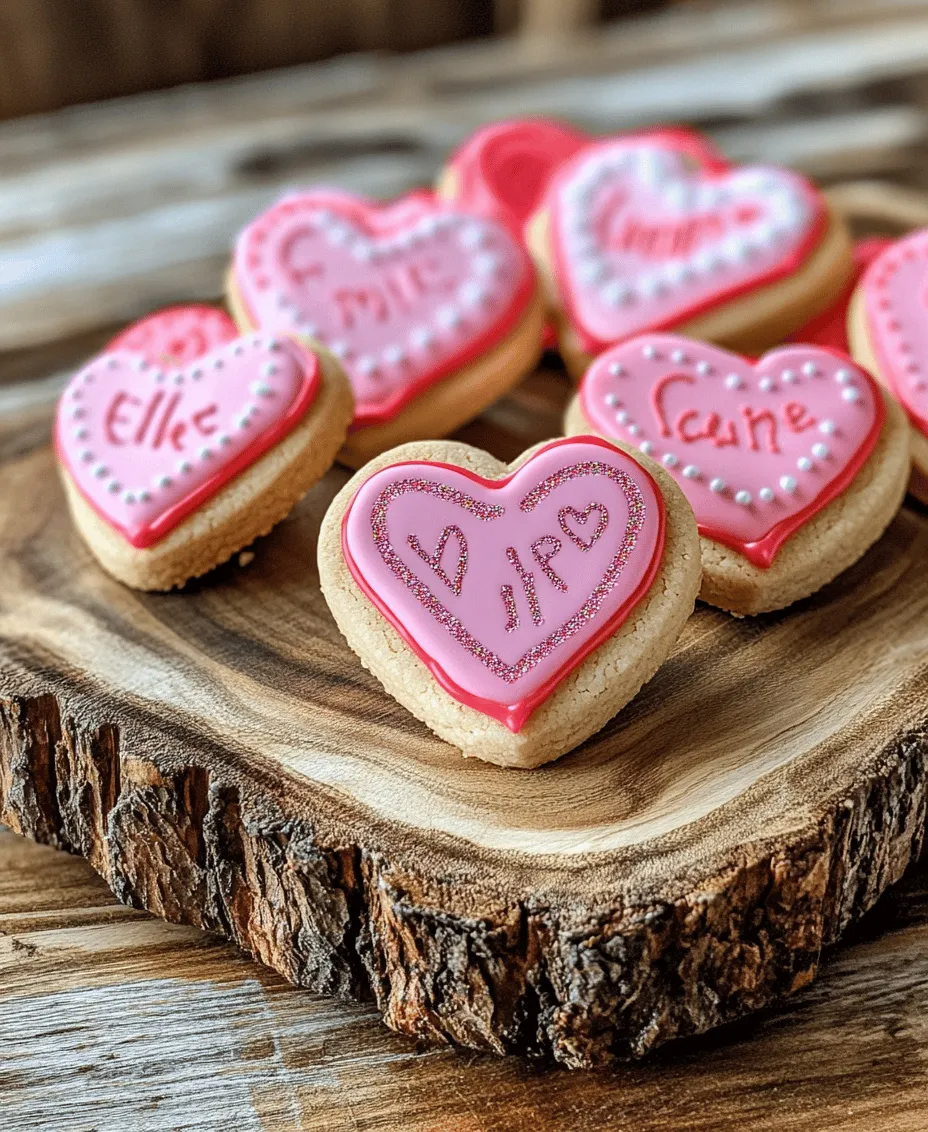Introduction
As Valentine’s Day approaches, love fills the air, and what better way to express affection than with a batch of delightful conversation heart cookies? These iconic cookies, adorned with sweet messages and vibrant colors, have become a staple treat during the romantic season. Not only do they make for charming gifts, but they also serve as a fantastic way to share heartfelt sentiments with friends, family, and that special someone. The beauty of conversation heart cookies lies in their versatility: they can be personalized with messages that resonate with the recipient, making each cookie a unique expression of love.
This recipe for soft and buttery conversation heart cookies stands out for its melt-in-your-mouth texture and rich flavor, ensuring that each bite is a delightful experience. The cookies are soft and chewy, thanks to the perfect balance of ingredients that work together to create a tender crumb. Additionally, the use of food coloring allows for an explosion of color, making these cookies not just delicious but visually appealing too. Whether you’re baking with your children, preparing for a romantic dinner, or hosting a Galentine’s Day gathering, these cookies provide a fun-filled activity that encourages creativity and fosters bonding time.
In this article, we will not only delve into the rich history and significance of conversation heart cookies but will also guide you through the steps of making these delightful treats. From understanding the key ingredients that contribute to their unique qualities to providing a detailed step-by-step guide, you’ll be well-equipped to create your own exquisite batch of conversation heart cookies.
Understanding the Ingredients
To achieve the perfect soft and buttery texture in your conversation heart cookies, it’s essential to understand the role of each ingredient used in the recipe. Each component plays a vital part in the overall structure, flavor, and appearance of the cookies.
All-Purpose Flour
At the foundation of any cookie recipe is flour, and for these conversation heart cookies, all-purpose flour is the star. It provides the necessary structure and stability to the cookies. The gluten formation in the flour contributes to the chewy texture while maintaining the cookies’ soft nature. It’s important to measure the flour correctly; too much flour can lead to dry cookies, while too little can result in spreading during baking.
Unsalted Butter
Butter is the key to achieving a rich, buttery flavor that is characteristic of these cookies. Using unsalted butter allows for better control over the saltiness of the final product. The fat in butter not only enhances flavor but also contributes to the cookies’ tender texture. When creamed with sugars, butter helps to incorporate air into the dough, resulting in a lighter, fluffier cookie.
Sugars (Granulated and Powdered)
In this recipe, both granulated and powdered sugars are used, each serving a distinct purpose. Granulated sugar adds sweetness and contributes to the cookie’s crisp edges, while powdered sugar, with its fine texture, helps to create a softer, melt-in-your-mouth consistency. The combination of these sugars ensures that the cookies are sweet without being overly so, allowing the buttery flavor to shine through.
Baking Powder and Baking Soda
Leavening agents are crucial for achieving the right texture in baked goods. In this recipe, both baking powder and baking soda are used to help the cookies rise while baking. Baking powder is a double-acting leavening agent, which means it works in two phases: once when mixed with the wet ingredients and again when exposed to heat in the oven. Baking soda, on the other hand, requires an acidic ingredient to activate it, creating carbon dioxide bubbles that lead to a light and airy cookie.
Egg and Vanilla Extract
Eggs are essential in cookie making, providing moisture and acting as a binding agent that holds all the ingredients together. They also enhance the structure of the cookies and add richness. Vanilla extract is a must-have flavor enhancer that complements the buttery taste of the cookies, adding depth to the overall flavor profile.
Food Coloring
One of the most exciting aspects of baking conversation heart cookies is the creative expression through colors. Food coloring allows bakers to customize their cookies for any occasion. For Valentine’s Day, pastel shades like pink, red, and lavender can create a whimsical and festive look. Using gel food coloring is often recommended, as it provides vibrant colors without altering the dough’s consistency.
Preparing for Baking
Before diving into the baking process, it’s crucial to prepare your kitchen to ensure a smooth and enjoyable experience. Proper preparation not only enhances efficiency but also contributes to the success of your baking endeavor.
Preheating the Oven
Preheating the oven is a fundamental step in baking cookies. The ideal temperature for baking soft and buttery cookies is typically around 350°F (175°C). Preheating the oven ensures that the cookies begin to bake immediately upon being placed inside, helping them to rise correctly and achieve the desired texture.
Preparing Baking Sheets
While the oven is preheating, take a moment to prepare your baking sheets. Line them with parchment paper or silicone baking mats to prevent the cookies from sticking and to promote even baking. This step makes cleanup easier and ensures that your cookies retain their shape while baking.
Kitchen Tools Needed
Having the right tools on hand can make the baking process more enjoyable and efficient. Here’s a list of essential kitchen tools you’ll need to make soft and buttery conversation heart cookies:
– Mixing Bowls: For combining ingredients.
– Measuring Cups and Spoons: For accurate measurements of dry and wet ingredients.
– Whisk: To mix dry ingredients thoroughly and to cream butter and sugars.
– Electric Mixer: For effortless creaming of butter and sugar.
– Rolling Pin: To roll out the dough to an even thickness.
– Cookie Cutters: Heart-shaped cookie cutters are essential for creating the iconic shape of these cookies.
– Spatula: For transferring cookies from the baking sheet to a cooling rack.
Importance of Mise en Place
Mise en place, a French culinary phrase meaning “everything in its place,” is a vital concept in baking. By measuring and organizing all your ingredients before you start mixing, you can ensure a more efficient workflow. It minimizes the chances of forgetting ingredients and allows you to focus on the baking process. Take the time to gather your ingredients and tools ahead of time, setting the stage for a successful baking experience.
Step-by-Step Instructions
Now that you’re prepared with the right ingredients and tools, it’s time to dive into the step-by-step process of making soft and buttery conversation heart cookies. Follow these instructions carefully for the best results.
Preheating the Oven
Start by preheating your oven to 350°F (175°C). This step is critical, as it allows the cookies to bake evenly and achieve the perfect texture.
Mixing Dry Ingredients
In a medium-sized mixing bowl, combine the all-purpose flour, baking powder, and baking soda. Use a whisk to mix the dry ingredients thoroughly. Whisking helps to evenly distribute the leavening agents throughout the flour, ensuring that your cookies rise uniformly during baking. Set this bowl aside.
Creaming Butter and Sugars
In a large mixing bowl, add the unsalted butter and both granulated and powdered sugars. Using an electric mixer, cream the butter and sugars together on medium speed until the mixture is light and fluffy. This usually takes about 3 to 5 minutes. The creaming process is essential, as it incorporates air into the dough, contributing to the cookies’ soft and tender texture.
Once the butter and sugar mixture is fluffy, add the egg and vanilla extract. Continue mixing until everything is well combined, and the mixture appears smooth.
—
With this foundation laid, you’ll be well on your way to creating a batch of delightful conversation heart cookies that will charm your loved ones and add a sweet touch to your Valentine’s Day celebrations. The subsequent steps will guide you through rolling out the dough, cutting the cookies, and baking them to perfection, ensuring that each cookie is a delicious work of art. Stay tuned for more detailed instructions that will lead you to cookie success!

Incorporating the Egg and Vanilla: Tips for Combining Wet Ingredients
To begin integrating the wet ingredients into your cookie dough, start by cracking your egg into a mixing bowl. Make sure to use a room-temperature egg for optimal mixing; this helps achieve a uniform consistency in your dough. Add in the vanilla extract, which not only acts as a flavor enhancer but also adds moisture to the mixture.
When combining these ingredients, use a whisk or a hand mixer at low speed to blend them just until they are combined. Avoid beating too vigorously, as this can incorporate excess air and lead to a less tender cookie. The goal is to achieve a cohesive mixture that is slightly frothy but not overly aerated. Once your egg and vanilla are well combined, it’s time to mix them into your dry ingredients.
Combining Mixtures: Importance of Not Overmixing and Achieving the Right Dough Consistency
When you combine your wet and dry ingredients, be mindful of the mixing process. Start by pouring the egg and vanilla mixture into the bowl containing your dry ingredients. Use a spatula or wooden spoon to gently fold the ingredients together. It’s crucial to only mix until you see the dry ingredients are fully incorporated; overmixing can result in tough cookies due to gluten development.
The ideal dough consistency should be soft and slightly sticky but manageable. If the dough seems too dry, you can add a teaspoon of milk to achieve the desired texture. Conversely, if the dough feels too wet, sprinkle in a little more flour until it holds together well. Remember, the key to soft and buttery cookies lies in this careful balancing act—aim for a smooth, pliable dough that doesn’t stick excessively to your hands.
Coloring the Dough: Guidance on Achieving Vibrant Colors Without Compromising Texture
For conversation heart cookies that truly stand out, consider adding color to your dough. Use gel food coloring for the best results; it provides rich color without altering the dough’s moisture content. Start with a small amount of gel, about the size of a toothpick, and knead it into the dough.
To achieve vibrant colors, gradually add more gel until you reach your desired hue. Keep in mind that colors may soften slightly when baked, so aim for a shade that’s a tad more intense than you want in the finished product. Ensure the food coloring is evenly distributed throughout the dough, creating a uniform color. This step not only enhances the visual appeal of the cookies but also adds an exciting element to the baking process.
Rolling and Cutting: Techniques for Even Thickness and Clean Cuts
Once your dough is prepared and colored, it’s time to roll and cut it into perfect shapes. Begin by chilling the dough for about 30 minutes; this firms it up, making it easier to roll out. On a lightly floured surface, roll the dough to an even thickness of about 1/4 inch. This thickness ensures that the cookies bake evenly and maintain their soft texture.
Use a heart-shaped cookie cutter to cut out the cookies, applying even pressure to achieve clean cuts. For added precision, dip the cutter in flour before each cut to prevent sticking. If you’re creating multiple colors of dough, consider rolling out each color separately and then combining them for a marbled effect. Once cut, place the cookies on a baking sheet lined with parchment paper, leaving space in between for spreading.
Baking and Cooling: Signs of Doneness and Cooling Tips for Ideal Texture
Baking is a pivotal step in creating the perfect cookie. Preheat your oven to 350°F (175°C) and bake the cookies for about 8-10 minutes. Keep an eye on them; the cookies are done when the edges are lightly golden but the centers still appear soft. Remove them from the oven and allow them to cool on the baking sheet for a few minutes before transferring them to a wire rack.
Cooling is crucial for the texture. If you leave them on the baking sheet for too long, they may become too soft and lose their shape. Once cooled completely, the cookies will set beautifully while retaining their soft and buttery center. Proper cooling also ensures that they are ready for decorating.
Decorating with Royal Icing: Techniques for Beautiful, Personalized Messages
Decorating your conversation heart cookies is where the fun truly begins! Royal icing is perfect for this task due to its smooth finish and ability to hold intricate designs. To make royal icing, combine egg whites or meringue powder with powdered sugar and water, mixing until you achieve a thick, spreadable consistency.
Transfer the icing to piping bags for easy application. Use a small round tip to outline the edges of each cookie, creating a barrier to hold in the flood icing. Once outlined, thin your icing with a little water until it reaches a pourable consistency. Flood the centers of the cookies and use a toothpick to spread it evenly. Allow the icing to dry completely before adding personalized messages with a contrasting color.
Creative Decorating Ideas
When it comes to decorating conversation heart cookies, the possibilities are endless. Here are some suggestions to inspire your creativity:
– Message Ideas: Personalize your cookies with classic phrases like “Be Mine,” “Love You,” or “Cutie Pie.” For special occasions, consider using names or inside jokes for a unique touch.
– Edible Glitter and Sprinkles: Enhance the visual appeal by sprinkling edible glitter or colored sprinkles on top of the wet royal icing. This adds a festive sparkle that’s sure to catch the eye.
– Neat Icing Designs: To achieve neat and clean designs, practice piping on parchment paper before decorating the cookies. This will help you get a feel for the flow of the icing and control the pressure on the piping bag.
Storing and Serving Suggestions
To maintain the freshness of your cookies, store them in an airtight container at room temperature. They can last for up to one week, but if you want to keep them longer, consider freezing them. Place the cookies in a single layer on a baking sheet to freeze, then transfer them to a freezer-safe container with parchment paper between layers. They will stay fresh for up to three months.
When it comes to serving, these cookies are perfect for various occasions. Package them in decorative boxes or bags as thoughtful gifts for friends and family. They make delightful treats for Valentine’s Day gatherings, classroom parties, or simply as a special surprise for your loved ones.
Nutritional Information
While these soft and buttery conversation heart cookies are a delightful treat, it’s essential to consider their nutritional aspects. Each cookie typically contains around 100-120 calories, depending on the size and the amount of icing used. They are generally high in sugar and fat, making them a special indulgence rather than a staple in your diet.
Enjoy these cookies in moderation, allowing yourself to savor the flavors and the joy they bring. Remember, the pleasure of baking and sharing these treats far outweighs the numbers on the nutritional label.
Conclusion
Baking soft and buttery conversation heart cookies is not only a delicious endeavor but also a beautiful way to express your creativity and affection for others. The process of mixing, rolling, and decorating allows you to connect with your loved ones, creating lasting memories and traditions.
Whether you’re making them for Valentine’s Day, birthdays, or just because, these cookies are sure to delight everyone who receives them. Embrace the joy of baking, and let these sweet treats become a cherished part of your special occasions. So gather your ingredients, unleash your creativity, and enjoy the wonderful experience of making and sharing homemade conversation heart cookies with those you hold dear.

